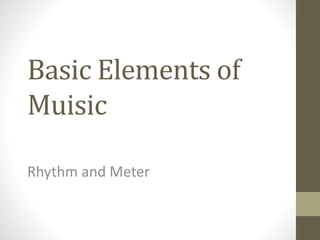
Rhythm and Meter
- 1. Basic Elements of Muisic Rhythm and Meter
- 2. Steady Beat Steady beat – the pulse of music. Tap to the steady beat in the following excerpts. http://magnatune.com/artists/albums/lara-bach/ http://magnatune.com/artists/albums/streicher-klaviertrios/ You will notice that some notes are equal to the steady beat, some are longer, and some are shorter.
- 3. Durations of Notes Quarter Note – q lasts for one steady beat Eighth Note – e two eighth notes are equal to one steady beat Sixteenth Note – xfour sixteenth notes are equal to one steady beat Half Note – h lasts for two steady beats Whole Note – w four steady beats long http://www.musictheory.net/lessons/11
- 4. Rhythmical exercise: tap your foot and clap your hands twice faster than a foot tap. You will clap two eighth notes (ee) per one quarter (q) foot tap. Experiment with various note durations. 1 2 3 4 1 & 2 & 3 & 4 & 1 e & a 2 e & a 3 e & a 4 e & a 1 2 3 4 1 2 3 4
- 5. Durations of Rests Quarter Rest – lasts for one steady beat Eighth Rest – two eighth rests equal to one steady beat Sixteenth Rest – four sixteenth rests equal to one steady beat Half Rest – lasts for two steady beats Whole Rest – four steady beats long Rests identify measured segments of silence in music.
- 6. Rhythm Rhythm – a pattern of durations of notes synchronized with the steady beat. Clap the following examples: q q q q iq q iq q h q q
- 7. Meter Arrangement of rhythms in a repetitive pattern of strong and weak beats. Meters can be classified by counting the number of beats from one strong beat to the next.
- 8. Simple Meters Duple – strong-weak. q q Triple – strong-weak-weak. q q q Quadruple – strong-weak- weak-weak q q q q
- 9. Measure Measure – a segment of time defined by a given number of beats. Bar lines – vertical lines that separate measures. The first beat in each measure is always strong. q q q q q q Example above can be represented by 2/4 time signature, in which 2 means that there are two beats in each measure and 4 stands for the value of one beat - 1/4 or a quarter note. Time signature can be considered as a fraction.
- 10. Clap the following excerpts: q q h iiiq q q q iq q iq q q h q q q iq 2 4 3 4 4 4
- 11. Clap the following. What are the time signatures? q q h iiiq jjjq q q q q iq q iq h q q q h q q q iq w
- 12. Bar Lines
- 13. Time Signatures 3 – three steady beats in each measure 8 – each beat is equal to an e
- 14. Common Time Signatures (Meters) • Top numeral indicates how many beats are in each measure. • Lower numeral indicates the note value that represents one beat.
- 15. Simple Meters Simple meters – each beat is divided into halves. • 2/4, 2/2, 4/4, 4/8, ¾ Listen to the 1st Movement of Haydn’s “Farewell” Symphony tapping to the steady beat. The beat can easily be divided onto two eighth notes. http://www.youtube.com/watch?v=KXctarOxRz8
- 16. Compound Meters Compound meters – each beat is divided into thirds. • 6/8, 6/4, 9/8, 12/8 Listen to the final movement of Corelli’s “Christmas Concerto” and tap to its slow steady beat. Each beat can easily be split onto three equal portions. http://www.youtube.com/watch?v=-Zs6_vsU9cg
- 17. Conducting Conductors use hand patterns to communicate meters (time signatures). This helps musicians to follow and play together. http://www.youtube.com/watch?v=79Pk-33R2HM
- 18. Duple Meter 2/4, 2/2, or fast 6/8 time
- 19. Triple Meter 3/4 or 3/2 http://www.youtube.com/watch?v=bjj84gcuMEw R. Wagner, Tannhauser Overture
- 20. Quadruple Meter 4/4, 4/2, or 4/8 Does Gustavo Dudamel (the conductor) always draw the 4/4 pattern? http://www.youtube.com/watch?v=Eo1KHr-b-CA
- 21. 6/8 Time Signature, Slow
- 22. Syncopation A disruption of the regular flow of rhythm, a replacement of stresses to where they would not occur. Please study the following. https://www.teoria.com/reference/s/syncopation.php?l=S
- 23. Listening Activity Listen to and conduct to the samples on this page. http://www.gmajormusictheory.org/Listening/meters/meters.ht ml
- 24. Required Readings • http://en.wikipedia.org/wiki/Time_signature • http://www.musictheory.net/lessons - read Note Duration and Measures and Time Signature in the Basics area • http://www.musictheory.net/lessons/15
